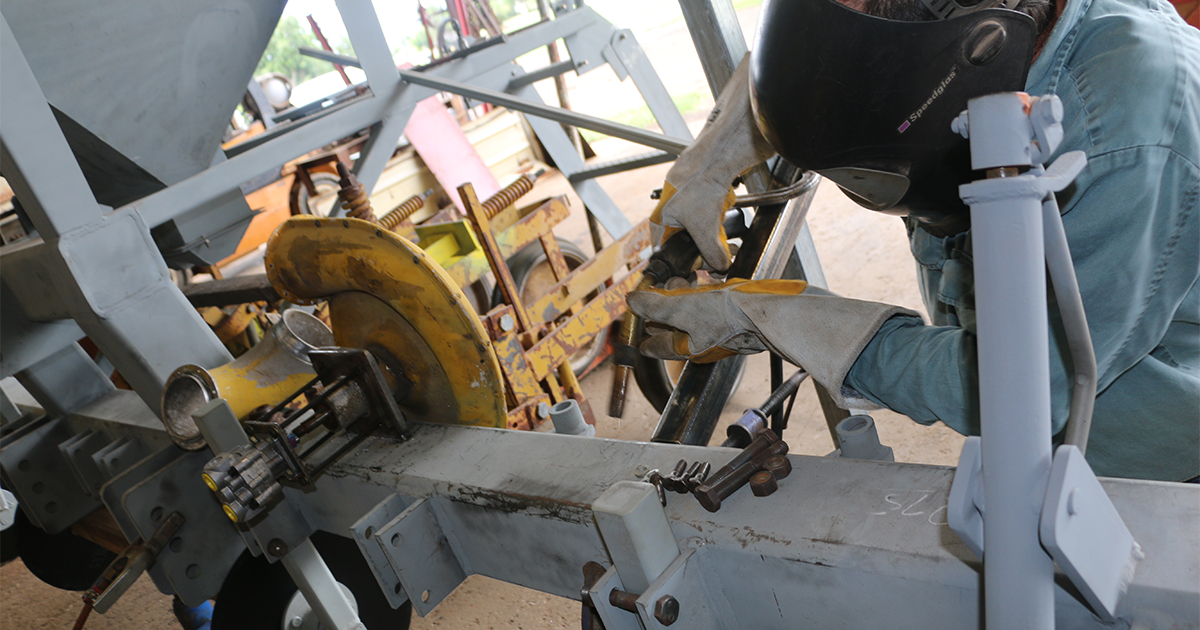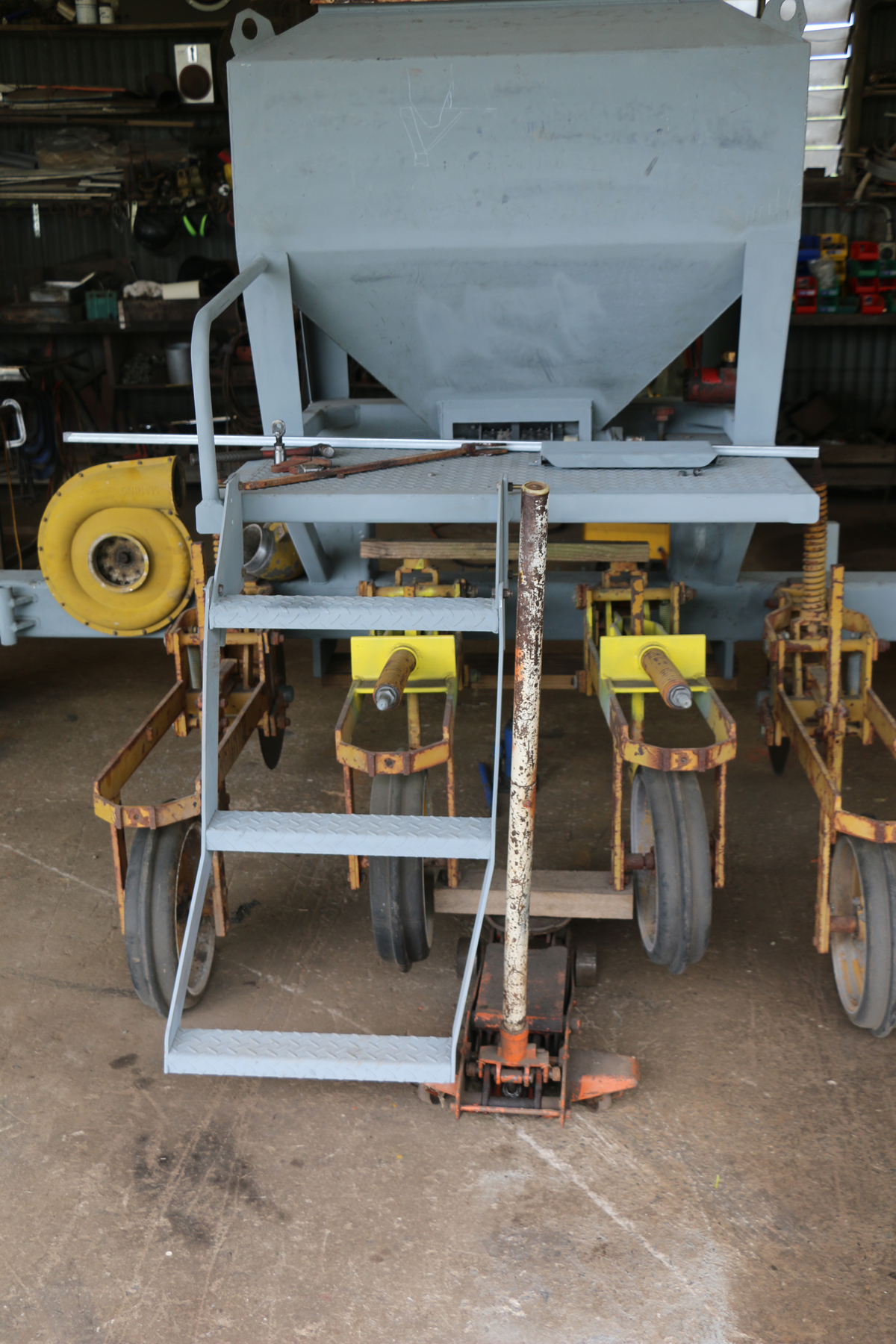New legume planter to help improve farming system
By Brad Pfeffer, Sugar Research Australia
Mackay cane grower Ray Abela has learnt lessons direct from the grains industry to improve his fallow cropping, and has put this knowledge to use by building a new implement this year.
This year has seen no shortage of wet weather days in the shed for many growers in northern parts of the Australian sugarcane industry. Ray Abela, who farms in the Central Region, has been in the same boat as many others, but the bright side is that it has given him more time for engineering his own precision air seeder.
When it has been raining, and even when it hasn’t, Ray has spent a lot of time grinding, welding and machining as part of this project that has been brewing in his head for a couple of years now.
He said the desire to build the air seeder was triggered by wanting a better way to get his fallow legumes in the ground and a chat with a retired broadacre grain grower.
“In talking, we quickly realised that there was plenty that the cane industry can offer the grain industry, and there’s also a lot we can learn from the grain industry, especially as we grow more of these crops in the fallow period,” Ray said.
“The air seeder is a combination of his advice and my experience and trying to put the two together into something that suits the farming system. I’ve used air seeders on properties out west, but by no means do I have an intricate knowledge of how they work.”
The design and the project has been a few years in the making, but it is coming to fruition this year. Ray has built it from the ground up, except for the legs, which he bought from a property near Moonie in southwest Queensland.

It’s an implement that he hopes will play a big role in ongoing work to improve his farming system and soil health, as well as letting him strike the windows of opportunity when they open. It is built to match his 1.9 metre row spacing and will plant four rows of legumes into each bed.
His current planter only plants two rows per bed, and he is also hoping this new implement will allow him to have more control over his plant population and utilisation of the bed. These are all questions at the moment and things that Ray is experimenting with.
The plan is to put it to work after the first round this season. For Ray, he normally fallows cane blocks after his first and second cuts, and then plants mung beans, which come off in December. This leaves time to plant soybean between December and January, which should go through to about May. After that, he plans for another crop, from a range of options such as oats or a mixed species fallow.
“I’ve then got time to spray it out and let it dry, and then prepare paddocks for planting cane in one pass.”
“That’s the theory, anyway,” he said. “The weather can beat us and we’ve made plenty of mistakes and learnt a lot of lessons along the way. The thing with mistakes is that there’s a lesson in them. I’ve had more failures than successes, but at least with legumes I’m not really losing because of the improvement to soil health and nutrition for the next cane crop.”
“It’s the reality of our environment with the humidity and rain that we are always going to have failures. But I’m trying to do what I can to remove the manmade errors from the equation.”
 Four row per bed legume air seeder build.
Four row per bed legume air seeder build.
Ray started making changes to his farming system around 2004/2005 when he faced both orange rust and low sugar prices and needed to cut costs. He decided he needed to spend money to save money, which led him to GPS, although admits it came with a steep learning curve in the early days.
He has shifted away from tillage as much as possible and rarely does a plough-out replant.
“Back then, I had a 185 horsepower tractor with dual wheels and 10 foot (3m) gear behind it, and I was noticing massive lumps in the paddock. But where I went zonal till and didn’t drive on the ground, the soil was friable,” he said.
“I’ve since gone to a smaller tractor and the ripper is sitting in the shed, half pulled apart. I have a 120 inch (3m) hoe that sits in the shed about eight years out of 10, and I’ve gone to an 80 inch (2m) hoe and use it at speed.”
The ripper has also changed from the 10-foot (3m) gear to a two-legged ripper with curved legs and operated at speed.
“I don’t want the machines burying themselves down and grinding everything to a pulp. Every lump in the soil is one I’ve created, so if I don’t create it then I don’t have to deal with it.”
He says his new farming system has significantly reduced costs, although is reluctant to say it has improved production.
“The only way to know that would be to have a ‘no treatment’ paddock, and to me that’s just not an option.”
Ray farms on 93 hectares just outside of Eton and said that for him he reckons future viability is about improving productivity and reducing cost on his existing land rather than expansion.
“It’s about keeping everything at low cost, utilising what we have.”
Source: Winter 2019 Cane Connection article re-published with permission from SRA.
Read Pulse Check blog articles | Pulse Check Coastal facebook | Subscribe to the monthly newsletter

